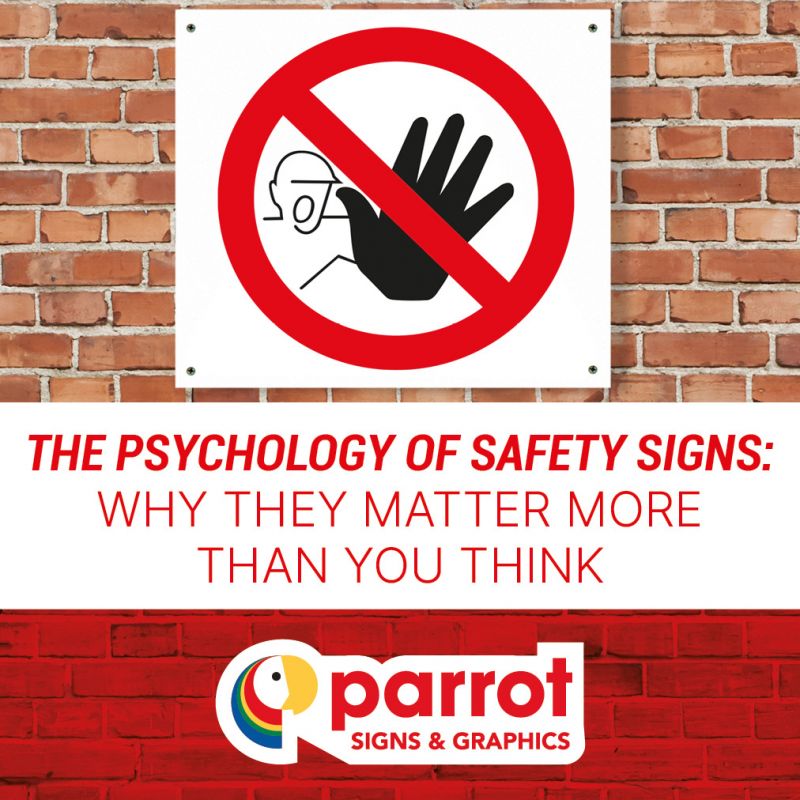The Psychology of Safety Signs and Why They Matter More Than You Think
Mon 28th April 2025Safety signs are an everyday part of the workplace. From warning labels to emergency exit signs, they're everywhere. But beyond their functional purpose, there’s an underlying psychology to safety signs that many business owners and managers overlook. In this article, we’ll delve into why safety signs do more than just convey information, they influence behaviour, shape perceptions, and play a critical role in reducing accidents.
Why Safety Signs Work: The Psychology Behind the Design
Have you ever walked into a factory or construction site and instinctively avoided a certain area because of a large "Danger" sign? That reaction isn’t accidental. The design and placement of safety signs are rooted in psychological principles. They’re meant to trigger an immediate, instinctive response.
-
Colour Psychology
Red, yellow, blue and green are not just random colours; they are carefully chosen to evoke specific emotions. Red signals danger or stop, making it a natural choice for fire safety signs or hazardous material warnings. Yellow, on the other hand, suggests caution, alerting workers to potential risks that aren’t immediately life-threatening. Green typically represents safety or "all clear," and you’ll often see it used for emergency exits or safe zones, while Blue represents positive, safe behaviour and encourages compliance. -
Shape and Size
The shape of a safety sign can also influence how it’s perceived. Circular signs (often blue) typically indicate mandatory actions, such as wearing protective equipment. Triangular signs (often with exclamation marks) are associated with warnings. The size of a sign plays a critical role as well - larger signs catch attention quickly and are more likely to be noticed in a busy environment. -
Visual Hierarchy
Your brain is wired to respond to visual cues, and safety signs are designed to work with that instinct. When you’re walking through a warehouse, for example, your eyes are naturally drawn to high-contrast signs. Bold, clear lettering combined with recognisable symbols (like a flame for fire hazards or a hand for electrical safety) help your brain quickly process and respond to important information.
How Safety Signs Influence Behaviour
It's one thing to have safety signs up, but another to understand how they actually influence employee behaviour. When placed properly, safety signs act as subtle nudges, reminding workers to stay alert, follow protocols, and avoid risky behaviour.
-
Prompting Safe Actions
A safety sign is often the first thing workers see when entering potentially hazardous areas. Clear instructions like "Wear PPE" (personal protective equipment) or "Wash your hands" remind them of the safety protocols they need to follow to keep themselves and their colleagues safe. -
Reducing the Risk of Accidents
Studies show that simply having visible safety signs in high-risk areas can reduce accidents by as much as 30%. Why? Because signs increase awareness, which leads to more cautious behaviour. Employees are less likely to skip safety checks or take unnecessary risks when they see clear warnings and instructions in place. -
Building a Safety Culture
Regular exposure to safety signs also plays a role in reinforcing a company’s safety culture. Employees who frequently encounter safety reminders throughout the workplace are more likely to internalise safe practices, making them second nature. It’s not just about preventing accidents in the moment; it’s about creating long-term habits.
The Right Signs for the Job: Customisation Is Key
While generic safety signs are useful, they don’t always address the unique needs of a specific workplace. Custom safety signs tailored to your industry and facility can have a more profound psychological impact.
For instance, a farm might need specific signs for livestock handling areas, while a manufacturing plant might require detailed warnings for machinery maintenance. Custom signage that speaks directly to the specific risks of your business is not only more effective but also enhances employee engagement by showing that safety is a top priority.
Conclusion: Don’t Underestimate the Power of Safety Signs
While safety signs are mandatory in many industries, their psychological impact goes far beyond compliance. They guide behaviour, shape perceptions, and significantly contribute to creating a safer work environment. The next time you walk through a factory or construction site, take a moment to consider the thought and psychology behind those signs because, whether we realise it or not, they’re working to keep everyone safe.
Remember, safety signs aren’t just an afterthought; they’re an essential part of your safety strategy, one that speaks louder than words.
